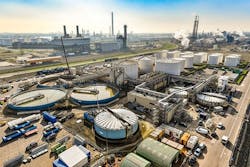Chemical makers are pursuing a variety of routes to improve energy efficiency, ranging from corporate programs and cooperative efforts with specific vendors to a global initiative. Many of these endeavors focus on taking greater advantage of digitalization and big data.
Aitor Bru, Barcelona, Spain-based global head of digital operations, group operational excellence, for Clariant, Muttenz, Switzerland, spends his time scouring for promising digital innovations and evaluating how they might improve the company’s operations and supply chains.
“We start from the business end. We don’t want to digitalize for the sake of it; we want to close gaps and meet a need. Energy is an important topic. Our vision is to reduce the energy intensity of our products contributing towards Clariant’s greenhouse gas (GHG) emission reduction targets,” he says.
“For example, once digitalized, systems can provide remote access to virtually every aspect of a plant with a multitude of tools collecting, reporting and allowing management of detailed features, such as consumption, utilities, raw materials, reactor temperatures, equipment performance and quality data — all within seconds,” Bru explains.
The company’s aim is a 40% absolute reduction in scope 1 and 2 GHG emissions, i.e., those from sources it owns or controls, and a 14% decrease in scope 3 emissions, e.g., ones generated in procurement, waste and water management, and business travel.
Clariant prides itself on being among the first specialty chemical companies to set such ambitious targets — ones in line with the Science Based Targets Initiative, a partnership of CDP, the United Nations Global Compact, World Resources Institute and the World Wide Fund for Nature (see: https://sciencebasedtargets.org).
A key tool to achieving this is Clariant’s dedicated diagnostic program Energy Watch (eWATCH).
Launched three years ago, eWATCH identifies opportunities to reduce the energy intensity of operations at every one of the company’s sites. The program has three pillars: collating information, analyzing it, and then acting based on the evaluations.
“The big advantage today is that we have the Internet of Things (IoT),” notes Bru. “That helps a lot with the granularity of our data. Plus, we get a lot more information than was possible in the past, at about a tenth the cost of installing an old-fashioned sensor and its associated wiring. Now, we just install the sensor, use wireless technology to send data to the cloud and then analyze it. The IoT has hugely improved the visibility of energy use in our operations.”
Clariant uses the IoT, on WiFi and other tools such as radio frequency identification and the LoRaWAN point-to-multipoint networking protocol, to analyze the resulting data repository. Here, it applies advanced data techniques on top of existing monitoring so individual sites can preset algorithms to help manage energy consumption and detect leaks, which also impact energy use.
The eWATCH team develops specific algorithms tailored for each site. These can be embedded into routine operations with results presented to plant staff as monitoring dashboards. The aim is continuous improvement, so review of the validity of key performance indicators occurs at least monthly.
Bru cites a Clariant site in Germany as an example of how eWATCH can identify energy-related issues. One plant there uses steam, generated by natural gas, to heat multiple individual reactors.
“The granularity of the measuring system wasn’t the best,” he notes. “We had the measurement of steam volume after the boiler but not for each reactor. So, we measured what were thought to be the highest consuming reactors.”
It turned out they actually weren’t the largest steam consumers. Clariant implemented a strategy of real-time steam consumption monitoring for each reactor and, in less than six months, reduced the amount of steam produced and, thus, natural gas needed. This allowed the site to pare its spending for natural gas by almost a quarter.
“One surprise is that the improvement in data granularity allows us to better understand individual contributors to consumption. Here, we get strong hints for the design of reactors and operational changes such as less heating time to reduce batch cycle times and increase reactor throughput,” Bru adds.
eWATCH also enables the company to compare similar processes operating at different plants.
“There is always some variability, even if processes and conditions are similar, but we can create a benchmark for the same product. Then, we can use this to create energy improvements in terms of electricity and natural gas consumption,” he concludes.
Better Control Loops
Drilling down to individual operations can enable significant energy savings, other companies have found. For instance, Emerson Automation Solutions, Round Rock, Texas, stresses that monitoring of control loops can lead to improvements that reduce process variability and the associated and often substantial energy losses.
“In a typical process plant, almost two-thirds of control loops are underperforming, which can be due to many reasons, including poor valve performance, incorrect loop tuning and inappropriate control strategy. As a result, huge amounts of energy are wasted because of suboptimal control, particularly in high-energy-use units, such as distillation columns, boilers, reactors, dryers and evaporators,” notes James Beall, a principal process control consultant for Emerson.
Poor tuning leads to greater process variability, he emphasizes. In turn, this spurs operators to run the plant away from the most-efficient regions, which typically are close to operating constraints, such as quality limits, to allow for a greater margin of error.
“For example, in a feed heater, this could mean a higher temperature setpoint and higher energy consumption. Despite process variability caused by poor control loop tuning being a regular feature of process plants, many facilities do not have a formal, consistent approach to troubleshooting, and the root causes of issues can, therefore, go undetected for weeks, months or even years,” Beall adds.
Unfortunately, many operating companies lack the tools, resources and skilled personnel needed to make the necessary improvements, he believes.
Here, automation providers can help, for example by using loop performance dashboards to measure the performance of every control loop, indicating when these have limited control, high variability, uncertain inputs or are not in the normal operating mode.
“Where performance issues are identified, control performance experts can support the customer to make improvements, with a remote service providing monthly reviews of control performance, identifying issues and making recommendations for corrective actions and prioritizing areas for the next month,” says Beall.
Due to the relatively low cost of enhancing the performance of regulatory control loops, they provide the highest return on investment of all process improvement efforts, he notes. In addition, when the regulatory control loops are performing well, existing advanced process control applications on the process can provide a higher level of economic benefits. Typical results of improvements in control loop performance include: 4–8% increase in throughput; 5–10% reduction in energy costs; 2–8% drop in product inventories; 40–80% decrease in quality variation; and 1–5% gain in equipment availability.
Beall cites a chemical company that worked with Emerson on its control loop tuning and improved the energy performance of a distillation column by 16%.
Process tests showed that the distillation column could produce on-specification product using less energy. However, lowering the setpoints on the control loops to the desired energy usage made the loops unstable.
“Through automated monitoring of the control loops and their components, we detected some poorly performing control valves and issues with the loops’ tuning. The team used this data to repair underperforming valves and install high-performance digital positioners that provided better performance and detailed status directly to the control system for faster resolution in the future,” Beall explains.
Armed with the new data and improved equipment, Emerson’s advanced control team tuned the loops as a system to provide a coordinated response and mitigate the normal loop interaction on a distillation column. The team also taught personnel at the chemical company their advanced loop-tuning techniques. The 16% reduction in energy use per unit of product paid for the improvements in two months.
Distillation columns in general offer opportunities for substantial energy savings. Beall notes that flexible advanced control technologies are ideally suited to supporting the complex tradeoffs between energy usage and product recovery in running a column. “They reduce key process variabilities, allowing operation closer to process constraints and limits, and further increasing energy efficiency.”
Another approach he highlights is state-based control (SBC), which uses a combination of operator-initiated state transitions and automated control logic to drive a process to a desired state.
“SBC automates workflows and provides decision support and simplified change management, three of the core competencies of digital transformation,” he points out.
New Global Initiative
Meanwhile in February, Shell, The Hague, The Netherlands; and Baker Hughes, Houston, announced they had teamed up with enterprise artificial intelligence (AI) software supplier C3 AI, Redwood City, Calif.; and Microsoft, Redmond, Wash., to launch the Open AI Energy Initiative (OAI). It aims to develop an open ecosystem of AI-based technologies for the energy and process industries. (A similar initiative already is well underway for open process automation; see: “Process Automation Opens Up,” and the CP on-demand webinar “Unlock Value from Open Process Automation.”)
“The concept of an open ecosystem is an acknowledgement that no single vendor alone has the capabilities to solve industries’ most pressing challenges. While AI brings significant promise and potential, the ability to scale it operationally requires a new approach which includes a modern set of technology standards and participation across the landscape of technology and supply chain participants,” explains Dan Brennan, vice president of BakerHughesC3.ai at Baker Hughes.
“Non-productive time remains a challenge across the energy value chain. The BakerHughesC3.ai alliance developed an application called BHC3 Reliability, which takes a novel systems approach to improve reliability by predicting asset failures and reducing unplanned downtime. The OAI builds on this premise,” he adds.
Together with Shell and Microsoft, Baker Hughes is extending the power of BHC3 Reliability by offering domain-specific modules to augment the application and by creating an open ecosystem that enables existing reliability software to interoperate with these AI applications (Figure 1).
Figure 1. New Open AI Energy Initiative eventually aims to cover all aspects of plant operations. Source: Baker Hughes.
“The OAI modules offered by Shell are a great example. Shell is taking proven capabilities that they have developed on the BHC3 AI Suite for predicting failure on control valves and making it available for other consumers of BHC3 Reliability,” Brennan notes.
Shell has been working with C3 AI since 2018 to scale its AI-based predictive maintenance technologies to reduce costs and improve the productivity, reliability and performance of its assets.
“We are monitoring more than 5,200 pieces of equipment using machine learning across upstream and downstream manufacturing as well as integrated gas assets [Figure 2]. We are now taking this capability to market and want to develop an open ecosystem where others can offer AI solutions to help improve reliability across the industry,” says Freddie Darbyshire, Shell’s digital product manager.
This follows the successful implementation of the Shell Predictive Maintenance for Control Valves application at a major refinery and, more recently, at a deep-water platform in the Gulf of Mexico. Within weeks of installing the C3 system, the application enhanced process stability; avoided pressure- or temperature-related trips on the main gas compressor; and halted unplanned downtime from valve failures, boosting production.
Darbyshire notes that Shell has quantified these benefits but isn’t sharing the information publicly.
The reliability technologies currently offered help address energy efficiency issues but sustainability options available shortly will aim directly at improving energy efficiency, he adds.
Figure 2. Shell is monitoring more than 5,200 pieces of equipment using machine learning. Source: Shell/Ernst Bode.
OAI welcomes input from process engineers about the technologies and features they would like the ecosystem to offer. Process optimization ideas would be particularly valuable, Darbyshire believes.
Brennan agrees, adding that while the OAI’s current focus on reliability should solve the persistent challenge of costly unexpected downtime and unplanned maintenance and their inherent risks and inefficiencies, process optimization, supply chain efficiency and scheduling optimization, as well as sustainability and energy management all will become part of the ecosystem.
The OAI also provides a springboard for energy operators, independent energy software vendors, equipment manufacturers, and service providers to offer additional interoperable technologies including AI and physics-based models, libraries, and data connectors to third parties, Brennan notes.
“We expect this will mean expanding in the future to other areas that help with business efficiency and decarbonization,” he concludes.
Seán Ottewell is Chemical Processing's editor at large. You can email him at [email protected].





